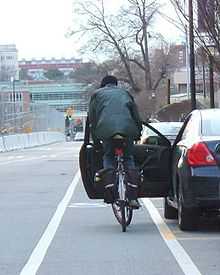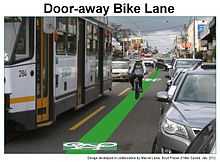Door zone



The door zone is the space in which a cyclist is in danger of getting hit by a car door. It varies depending upon the model of car one is riding by. It can be almost zero when riding by a vehicle with gull-wing doors or much larger if one is riding by a truck.
Legal issues
Most areas have laws that require car users to check for bicyclists before opening the door of their vehicle,[1] but there have been serious injuries and deaths caused by drivers illegally opening their doors in the path of a passing cyclist where this is prohibited by law.
Many areas have laws requiring cyclists to ride in the door zone, meaning they may expose themselves to danger in order to keep out of the way of motorized traffic. These laws typically have exceptions; avoiding hazards, such as an open door, is sometimes among them.
The problem lies with avoiding this 5 feet (1.5 m) zone, which should be part of the parking zone, when there is a bike lane or the perception by law enforcement or motorists that one should be riding their bike out of the travel lane to not impede faster motorized traffic. In most jurisdictions, a cyclist is considered a driver/operator of a vehicle afforded the same rights as the driver of a motor vehicle; however, in some jurisdictions cyclists are further restricted by laws such as "ride as far right as practicable." From a cyclist's point of view, "practicable" includes safety, and safety is noted in many of these laws through exceptions; however, many law enforcement, judges, motoring public and even cyclists stop reading at "as far right." Most motor travel lanes adjacent to a bike lane are only 10–11 feet (3.0–3.4 m) wide, so if a cyclist has to use that lane to avoid hazards in the bike lane, it is too narrow to safely share with passing traffic and he/she should ride in a "lane-control" method as is allowed by most of these ordinances.[2]
Avoidance
Because it is rarely possible to see and react safely to a suddenly opening door, traffic cycling educational programs teach cyclists to ride in the travel lane outside of the door zone despite the fact that in one place, NYC, for example, 96% of deaths have occurred outside of the door zone.[3] This is easier than locating bike lanes outside the door zone and increasing the space set aside for motor vehicles to accommodate the door zone.
Prevalence
It is difficult to find statistics on the incidence of door zone fatalities, serious injuries, and collisions as the type of accident is often not recorded consistently from city to city. However, an analysis of Chicago bike crashes found that there were 344 reported dooring crashes reported in 2011, for a rate of 0.94 doorings per day. Doorings made up 19.7% of all reported bike crashes. The number of additional doorings that occurred without being reported is unknown.[4]
Collisions
In Toronto, "motorist opens door in path of cyclist" collisions were 11.9% of all reported car/bike collisions in 2003.[5] Eight percent of serious injuries to cyclists in London in 2007 were caused by cyclists swerving to avoid opening car doors.[6] In the Australian state of Victoria between 2006 and 2010, car door openings caused eight percent of serious injuries to cyclists.[7]
Relative risk
Relative to other collisions such as getting rear ended, getting doored is less risky: "80.04% of those cyclists who were doored were injured, while 94.40% of those in non-dooring crashes were injured."[4] Also, it should be noted that getting doored itself usually is not fatal; rather, most serious door-zone-related injuries are sustained by getting hit by a motor vehicle while swerving to avoid the door. Thus, most deaths and serious injuries occur in the travel lane and not in the door zone.
Fatalities
In New York City, 3% (7 out of 225) of bicyclist fatalities in the ten-year period between 1996 and 2005 were from striking an open door or swerving to avoid one.[3] In London three people were killed in car door opening incidents between 2010 and 2012.[6] While there were 1112 collisions caused by opening doors in the Australian state of Victoria between 2000 and 2010, the first fatality occurred in March 2010.[8]
See also
References
- ↑ "No person shall open the door of a vehicle on the side available to moving traffic unless it is reasonably safe to do so and can be done without interfering with the movement of such traffic..." CA CVC 22517
- ↑ ...(vii) a lane that is too narrow for a bicycle and a vehicle to travel safely side by side within the lane UCA 41-6a-1105
- ↑ 3.0 3.1 "Layout 1" (PDF). Retrieved 2013-05-08.
- ↑ 4.0 4.1 September 28, 2012 (2012-09-28). "Doorings in Chicago and NYC are still a sorry state but one of them is doing something about it". Grid Chicago. Retrieved 2013-05-08.
- ↑ "City of Toronto: Transportation Services". Toronto.ca. Retrieved 2013-05-08.
- ↑ 6.0 6.1 Laker, Laura (24 July 2012). "Cyclists must steer clear of the threat of parked cars". The Guardian. Retrieved 29 March 2015.
- ↑ "Heavy toll of car dooring incidents points to need for bigger fines". Slater and Gordon Lawyers. 31 August 2012. Retrieved 29 March 2015.
- ↑ Power, Liza (26 November 2011). "Reflecting on a tragedy". The Sydney Morning Herald. Retrieved 29 March 2015.
External links
- The "Door Zone" includes instructive diagrams.
- The Door Zone Project
- Door Zone Avoidance Preston Tyree, recently retired Education Director at League of American Bicyclists, teaching LCI (instructor) candidates how to teach about the door zone.
- Why You Should Avoid the Door Zone Video showing how bicyclists are thrown into traffic when they collide with an opening car door.
| ||||||||||||||||||||||||||